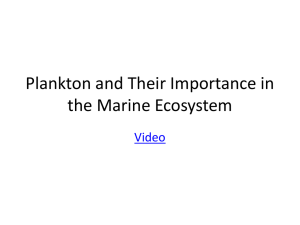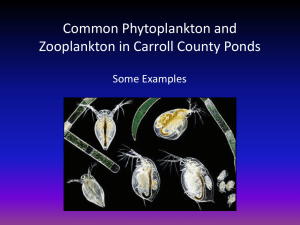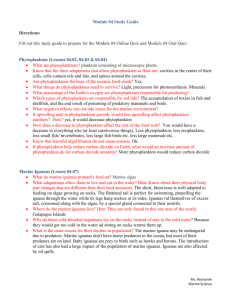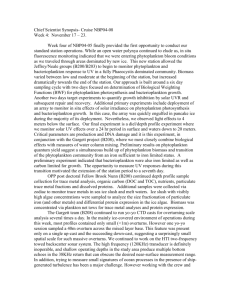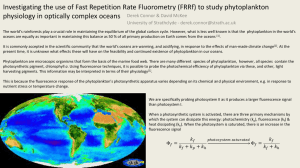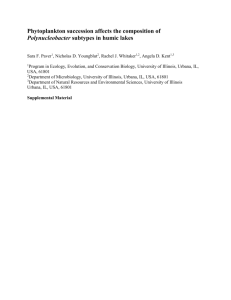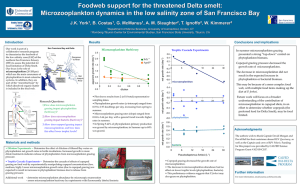CHAPTER 6 ECOLOGY OF PHYTOPLANKTON
advertisement
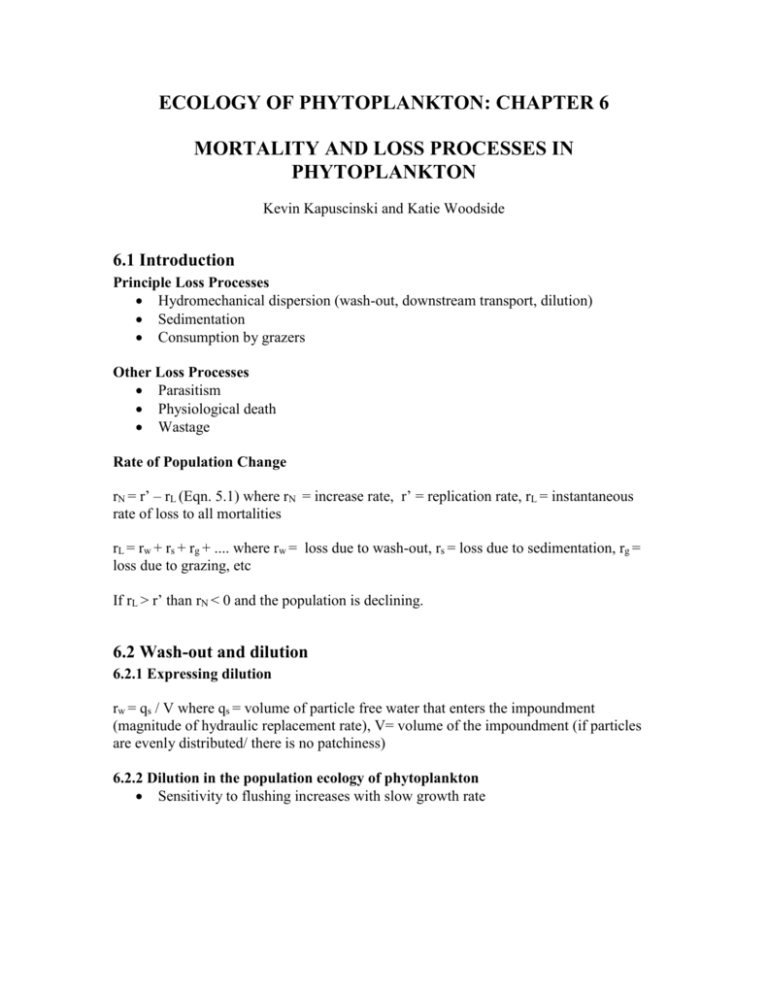
ECOLOGY OF PHYTOPLANKTON: CHAPTER 6 MORTALITY AND LOSS PROCESSES IN PHYTOPLANKTON Kevin Kapuscinski and Katie Woodside 6.1 Introduction Principle Loss Processes Hydromechanical dispersion (wash-out, downstream transport, dilution) Sedimentation Consumption by grazers Other Loss Processes Parasitism Physiological death Wastage Rate of Population Change rN = r’ – rL (Eqn. 5.1) where rN = increase rate, r’ = replication rate, rL = instantaneous rate of loss to all mortalities rL = rw + rs + rg + .... where rw = loss due to wash-out, rs = loss due to sedimentation, rg = loss due to grazing, etc If rL > r’ than rN < 0 and the population is declining. 6.2 Wash-out and dilution 6.2.1 Expressing dilution rw = qs / V where qs = volume of particle free water that enters the impoundment (magnitude of hydraulic replacement rate), V= volume of the impoundment (if particles are evenly distributed/ there is no patchiness) 6.2.2 Dilution in the population ecology of phytoplankton Sensitivity to flushing increases with slow growth rate 6.2.3 Phytoplankton population dynamics in rivers Larger rivers (3rd or 4th order) support populations of river plankton (potamoplankton) in non-flowing water Non-flowing water Boundary friction between banks and bed Fluvial ‘deadzones’ (little ponds within the river) sensitive to changes in discharge, fluid exchange, and turbidity C-strategists and CR-strategists do well in rivers Consumption by filter-feeding zooplankton and zoobenthos Macrophytes in headwaters and lateral dead-zones act as shelters and substrata 6.3 Sedimentation 6.3.1 Loss by sinking Turbulent entrainment slows sinking Non-motile organisms vulnerable to variations in mixed depth Small, motile, or minimization of density helps reduce sinking rates (Stokes eqn.) 6.3.2 Mixed depth and the population dynamics of diatoms Colony formation and siliceous exoskeletons provide increased form resistance and entrainability Dependent on turbulence and absolute mixed-layer depth for dispersal and population recruitment (intensity and extent of vertical mixing) Lack of nutrients = heavy sinking losses Onset of stable thermal stratification = higher sinking losses Shortening mixing depth = accelerated rate sinking rate = accelerated sinking loss Accelerated sinking rate could be positive mechanism used to escape near-surface insolation, could allow for population re-establishment upon better conditions Large phytoplankton succumb more to sedimentation than colonial phytoplankton Sedimentation main loss of limnetic (open-water) phytoplankton Sedimentation leads to seasonal succession of other phytoplankton 6.3.3 Accumulation and resuspension of deposited material ‘Seed banks’ need to survive and escape back into water column Resting stages with independent capacity for germination, regrowth, and reinfection Resting cysts and stages that depend on still-suspended or resuspended propagules encountering tolerable conditions As sediment builds up, materials are compacted and lost from semifluid layer, water and biominerals are lost upon compaction Filaments and chains exist in semifluid layer longer than centric unicells Resuspension dependent on: Sufficient turbulent force Depth of sediments Borrowing of invertebrates, fish, etc 6.4 Consumption by herbivores 6.4.1 The diversity of pelagic phagotrophs and their foods Zooplankton – feed on live or detrital organic particles for most/all energy and carbon Protistan microzooplankton <200 m heterotrophic protistans and metazoans Many photoautotrophs with phagotrohpic capabilities Planktic ciliates can ingest long filaments by coiling them intracellularly Feeding largely depends on encounter/chance Multicellular microzooplankton Marine - larval crustaceans, rotifers, larvaceans, larvae of other groups (molluscs and echinoderms) Marine - feeding largely depends on encounter, cilia around mouth, mandibular mouthparts Lakes – rotifers, copepod nauplii Freshwater mesozooplankton 0.2 – 2 mm Can exploit currents and turbulence Common adaptations – transparency, ability to propel self Copepods (cyclopoids and calanoids) Cyclopoids – short biramous antennules, pear-shaped, thoracic legs Calanoids – long antennules, cylindrical shape, can filter feed via currents created by appendages or actively capture larger algae and ciliates Branchiopods (Cladocera) Specialized filter-feeders drawing water through carapace Short abdomen and thorax covered by carapace, 4 to 6 pairs limbs with setae, large biramous antennae Daphniidae Marine mesozooplankton Calanoids, cladocerans, thaliacean tunicates (salps) Calanoids are more efficient carbon harvesters than cladocerans Cladocerans can filter more water, harvest more food, faster metabolism and growth than calanoids in nutrient rich environments Tunicates – gelatinous, barrel-shaped, low body mass filter-feeders Planktivorous macroplankton, megaplankton and nekton Trophic cascades with zooplanktivorous fish Macroplankton (2 to 20 mm), Megaplankton (>20 mm) – polychaetes, amphipods, larval decapods, larval hemipterans Swimming nekton (fish, squid) and their juvenile hatchlings 6.4.2 Impacts of filter-feeding on phytoplankton Means to sieve and concentrate particles Filtration rates versus Feeding rates Food availability Depends size of filter, leakage Size and texture of food Chemoreception Kairomones (undigestable cells) Production of toxic substances by phytoplankton Mucilage decreases successful ingestion Algal removal and grazer nutrition Without predators it depends on temperature and food availability Food thesholds and natural populations Larger filter-feeders have larger resource base than smaller filter-feeders Algal food resource supplemented by detritus and bacteria Larger zooplankton more vulnerable to predation Feeding pressure on zooplankton varies (fish switch between benthic and planktic resources) 6.4.3 Selective feeding Filter-feeding plus active capture through chemoreception, scraping, fragmenting food 6.4.4 Losses to grazers Filter-feeding more damaging than selective feeding 6.4.5 Phytoplankton-zooplankton interactions (zooplankton don’t control phytoplankton in predictable way) Competitive interactions Cladocerans select against small algae leaving large indigestible algae for daphniids Feedbacks Excretory wastes, sloppy eating (recycled nutrients) Bottom-up and top-down processes in oligotrophic systems (resource restraints) Bottom-up and top-down processes in enriched systems Control of system can switch from top-down to bottom-up and vice versa Seasonal, temperature influences who has control Intervention in food-web interactions Catastrophic events (fish kills, toxic substances) Invasions of exotics Food-chain length Determined by stability of key components, availability of resource base, usable energy influx. (Overall transfer of energy through trophic levels important) Stable isotope analyses of food webs show that size of ecosystem and totality of resources more important determinants 6.5 Susceptibility to pathogens and parasites 6.5.1 Fungal parasites Difficult to distinguish except based on host Host cells almost always killed Under low light, low infection rates 6.5.2 Protozoan and other parasites Often wrap around algae or suck out contents through holes made in cell walls 5.5.3 Pathogenic bacteria and viruses More common in lakes than oceans Viruses may be dormant for years 6.6 Death and Decomposition Failure of organism to maintain basic metabolic functions Programmed cell death (apoptosis) 6.7 Aggregated impacts of loss processes on phytoplankton composition Seasonal succession, succession of different phytoplankton species Salps Class Thaliacea http://www.earthlife.net/inverts/images/others/salp.jpg http://www.amonline.net.au/fishes/fishfacts/images/salp.jpg Tunicates http://www.aquamarinediving.com/images/DFugitt_Bali_Tunicates.jpg References Blindow, I., A. Hargeby, B.M.A. Wagner, G. Andersson. 2000. How important is the crustacean plankton for the maintenance of water clarity in shallow lakes with abundant submerged vegetation? Freshwater Biology 44:185-197. Caraco, N., J.J. Cole, S.E.G. Findlay, D.T. Fischer, G.G. Lampman, M.L. Pace, and D.L. Strayer. 2000. Dissolved oxygen declines in the Hudson River associated with the invasion of the Zebra Mussel (Dreissena polymorpha). Environmental Science and Technology 34(7): 1204-1210. Crumpton, W. G. and R.G. Wetzel. 1982. Effects of differential growth and mortality in the seasonal succession of phytoplankton populations in Lawrence Lake, Michigan. Ecology 63:1729-1739. Fuhrman, J. A. 1999. Marine viruses and their biogeochemical and ecological effects. Nature 399:541-548. Landry, M. R., and R. P. Hassett. 1982. Estimating the grazing impact of marine microzooplankton. Marine Biology 67:283-288. Post, D.M. 2002. Using stable isotopes to estimate trophic position: models, methods, and assumptions. Ecology 83(3):703-718. Reynolds, C. 2006. Ecology of Phytoplankton. Cambridge University Press. Cambridge, UK. Timms, R.M. and B. Moss. 1984. Prevention of growth of potentially dense phytoplankton populations by zooplankton grazing, in the presence of zooplanktivorous fish, in a shallow wetland ecosystem. Limnology and Oceanography 29(3): 472-486. Vander Zanden M.J. and J.B. Rasmussen. 1999. Primary consumer 13C and 15N and the trophic position of aquatic consumers. Ecology 80(4):1395-1404. van Donk, E. and W.J. can de Bund. Impact of submerged macrophytes including charophytes on phyto- and zooplankton communities: allelopathy versus other mechanisms. Aquatic Botany 72:261-274. Zhu, B., D.G. Fitzgerald, C.M. Mayer, L.G. Rudstam, and E.L. Mills. 2006. Alteration of ecosystem function by zebra mussels in Oneida Lake: impacts on submerged macrophytes. Ecosystems 9:1017-1028.
